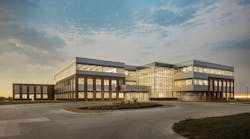Unraveling the mystery of 3-D modeling
Ask any three people in the construction business what comes to mind when you mention the phrase "3-D model," and you'll most likely get three different answers.
To some a 3-D model is a geometric representation of either all or part of a building that is created to communicate a particular design idea.
Others might think of 3-D modeling as something that is created to solve a specific design problem: for example, examining a particular space while lit with sun and then examining that space under the conditions of the proposed lighting scheme.
Still others may think of a 3-D model as a database repository for all of the nuts-and-bolts construction data involved with a project.
Because of the conflicting understanding of the concept, three-dimensional models become difficult to talk about, even more difficult to create, and almost impossible to share among Building Team members. To further murk the waters, in the construction business, the geometric model of a building is often intimately intertwined with the 3-D process model of how it's ultimately created and 3-D performance models of how one or more of its many components perform.
So it's no wonder that the holy grail of modeling is a single model that's created at the time of a building's inception, built up throughout the design and construction process, and eventually maintained and enhanced throughout the entire life of a facility.
To get a sense of just a few of the possible uses of a 3-D model, firms that specialize in creating and updating them as a service offer a literal menu of services.
The uses of 3-D modeling go well beyond mere presentation graphics, says John (Jack) de Valpine, a principal with 3-D modeling and rendering firm Visarc, based in Charlestown, Mass. "Presentation is just a piece of the pie," says de Valpine, who holds an MArch from Massachusetts Institute of Technology, as does his business partner, Benjamin Black. "Our services are used simultaneously by different parties for different but complementary purposes."
De Valpine says Visarc's clients are using 3-D modeling for a wide variety of purposes (see box, page 12).
In all cases, de Valpine says, the firm's architectural visualizations are being used to facilitate the communication of critical design-related information.
Most nonresidential building designers first create a model's 3-D geometry in Autodesk's AutoCAD. Visarc uses AutoCAD 2000. But instead of creating "solid" models based on volumes, Visarc uses a proprietary method of creating models based on polygonal-shaped surfaces. With that approach, files are both substantially smaller and much easier to work with, especially when implementing the inevitable changes that occur during the design process.
If a building has a difficult curved surface, the firm will supplement the model-creation process with a program called Rhinoceros from Robert McNeel and Associates. Rhinoceros' surfaces can have shapes beyond the capability of solid modelers, and the program is capable of designing structures as elaborately curved as the Bilbao Museum in Spain. But the product doesn't create the CAD files needed for automated interfacing with advanced steel fabricators, such as architect Frank Gehry did on that same project using mechanical CAD design program CATIA from Dassault Systems.
For rendering, Visarc relies on a UNIX-based suite of programs called Radiance, which are designed to analyze and simulate lighting. Developed at the U.S. Department of Energy's Lawrence Berkeley (Calif.) National Laboratory, the suite is more complicated than most rendering systems. The compelling advantage that de Valpine touts is that instead of adding artificial effects from a program such as Photoshop to achieve a desired appearance, Radiance is "physics based."
To create 3-D renderings, the suite draws on physical properties of building materials and fixtures, such as the type of reflectance a material has, the type of light transmission if it's glazing, and photometric descriptions of light sources. Input files for Radiance can include scene geometry, materials, luminaires, time of day, date, and sky conditions. Geometric 3-D representations of wall surfaces, ceiling surfaces, floor surfaces, and furniture are joined with descriptions of material properties, such as color or texture. According to the DOE, the software can predict illumination, visual quality, and appearance of proposed spaces. Visarc uses the software to enhance its ability to help architects predict and solve design problems early in the process.
Sweet and simple
Simplicity often leads to greater effectiveness, and in the world of software it always captures attention. That's why a 3-D design program introduced last year called Sketch-Up from @Last Software, Boulder, Colo., has created a growing legion of advocates and is making inroads in the 3-D market, although at a much more rudimentary level. Users laud its exceptional interface for enabling a novice to create a 3-D model less than eight hours after first trying the program.
On a larger scale, vying to a growing share of the 3-D modeling market are firms offering data-driven parametric design programs, such as Revit from Autodesk and ArchiCAD from GraphiSoft, based in Budapest. Both are capable of the Single Building Model approach, where the model acts as a repository for all different kinds of project data.
Last June, Finnish software start-up Enterprixe Software Ltd., headquartered in Helsinki, debuted an Internet-based collaborative building design system that's a shared repository of design team communications and decisions.
While the database-driven model is stored on the vendor's servers, users anywhere in the world with an Internet connection can run a local software program, such as Autodesk Architectural Desktop, to view and edit the model.
Looking ahead, computer graphics researchers at Cornell University's Computer Graphics and Scientific Visualization Center in Ithaca, N.Y., are attempting even loftier goals: to create a 3-D whiteboard that would work over the Internet, thus enabling Building Team members to collaborate, make modifications, and view each other's work in real time.
Cornell researchers are also working on new algorithms aimed at speeding up rendering programs by a factor of 1000. According lab director Donald Greenberg, the goal is to be able to render while modeling, giving designers more immediate and realistic feedback on the structures they create.
Matthew Phair ([email protected]) is a New York-based writer who explores innovation and technology in the engineered construction process.
| For more product information | ||
| ArchiCAD: www.graphisoft.com | AutoCAD 2000: www.autodesk.com | CATIA: www.3cb.com/en |
| Enterprixe: www.enterprixe.com | Radiance: www.lbnl.gov | Revit: www.autodesk.com |
| SketchUp: www.sketchup.com | Visarc: www.visarc.com | |

